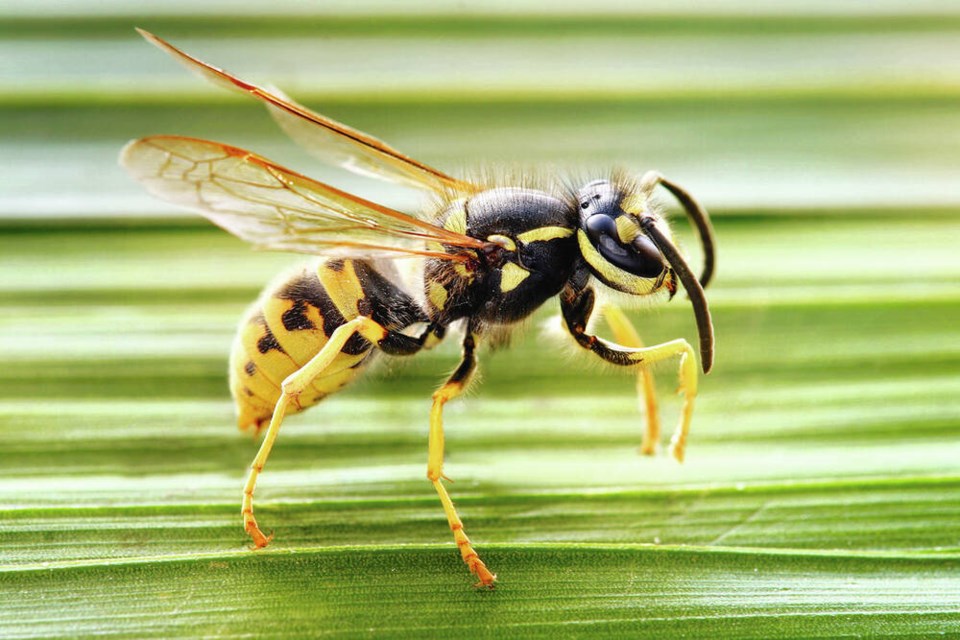There’s a lot going on in the backyard today. One of those dog fights you read about, only sans dogs: A lone brave hummingbird has taken on three wasps for aerial access to the hummingbird feeder.
The wee bird dips, dives and dodges his way to the sugar water, burning calories, only to be driven away again and again by the threat of a wasp sting, which will stop his heart and end his song forever.
I don’t know what kind of hummingbird — of the 350 species in the world, five are native to British Columbia — but I am rooting for the little guy. I swat at the wasps, who immediately turn on me, giving the hummingbird a chance to dart in and replace his fuel reserves.
I don’t know what kind of wasps, either — there are 18 species of wasps and hornets in B.C. — but each bears the telltale signs of a diabolical villain: black and yellow costume; super-aggressive attitude; and that sharp reminder on the business end that even though I am roughly 10,000 times larger, I am afraid of them. The wasps, after all, brought a tactical nuclear warhead to a sugar-water fight.
If you spend any of your summertime on the West Coast you know that wasps can be … what’s the word I’m looking for? Annoying? Ouchy?
They are the insect equivalent of relatives who, instead of talking about an issue you disagree on, send a link to a Jordan Peterson video. If you don’t know what I mean, you might be that relative, or that wasp.
Of course, wasps have an important role in balancing British Columbia’s natural ecosystem, by which biologists mean keeping the spider and insect populations down, and not letting humans enjoy picnics too much.
Here’s how to minimize your chances of being stung by a wasp:
• Remove all outdoor food sources attractive to wasps, such as pets and children.
• Avoid sitting or standing on a wasp nest, or going outside during the summer months.
• Never swat at a wasp hovering around you; instead, quietly move away and call the police.
• Turn off social media.
There are plenty of good reasons why we have hummingbird feeders, but not wasp feeders. Wasps are a dime a dozen during these dog days of summer, whereas hummingbirds are … what?
I’ll tell you what: Hummingbirds are a marvel of engineering that pushes the limits of biology. They are preposterous and their existence is unlikely in the extreme. I love them for this.
For example, hummingbirds can hover and fly backwards. Their little wings beat 55 times per second, while they breathe 150 times per minute and their hearts beat 1,260 times per minute.
A baby hummingbird is roughly the size of a jellybean and is unable to fly, coming from an egg that weighs less than 1/50 of an ounce.
Wait, there’s more: the eight-cm-long rufous hummingbird (Selasphorus rufus) has the longest migration of any hummingbird species, travelling 5,000 kilometres from Alaska to southern Mexico (and 5,000 km back) every year. The ruby-throated hummingbird (Archilochus colubris) flies 800 km non-stop across the Gulf of Mexico during both spring and fall migrations.
Hummingbirds have tongues that are grooved, and in cross-section look like the shape of the letter “W.” Their tongues also have tiny hairs on the tips to help them lap up cats. Sorry, wait … checking my notes … that should probably say lap up LIKE cats.
Obviously, the science is not clear and somebody should check for a Jordan Peterson video to sort out this cat business.
Hummingbirds, just like Canadian rock band Trooper, are here for a good time, not a long time. Most species live for only three to five years. Before they die, male hummingbirds forgo humming in favour of denture-whistling Streets of Laredo over and over, and jingling pocket change while complaining about Ottawa.
Finally, a group of hummingbirds is called a “charm,” which sounds nicer than a “murder of crows” or an “Elon Musk of seagulls.”
What charms me most is the sense of wonder that hummingbirds still provoke despite all the wasps in my life. At my age and stage, I admit to a certain amount of cynicism and ennui battling for control of my thoughts. It’s a natural hazard of growing old with an internet connection.
I have travelled much and seen more in life, and feel tired, spread a little too thin, like Bilbo after carrying The One Ring.
Maybe you feel that way too; we live in the same society, full to the brim with frightened people, full of sound and fury, signifying nothing on social media all day long. They are wasps, and swatting at them is exhausting.
But hummingbirds are tiny marvels, a daily antidote to the modern disease of suspicion and scorn. Their form and function is on the very edge of what is biologically possible, somehow highlighting the breathtakingly beautiful and amazing natural world around us on Vancouver Island.
They are proof God is a master craftsman who delights in creating the wonderful to astound and refresh us. They remind us not all in life is wasps.
>>> To comment on this article, write a letter to the editor: [email protected]



